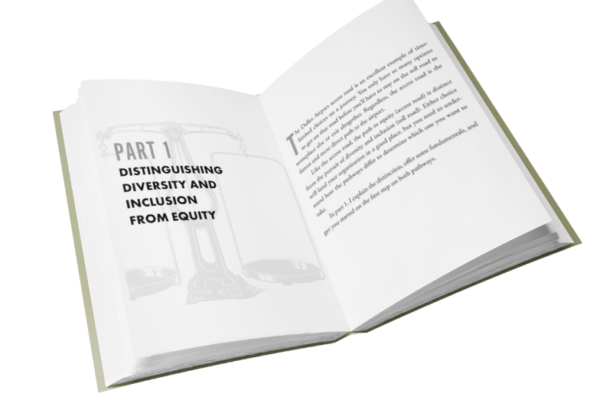NOT YOUR FATHER'S CAPITALISM

NOT YOUR FATHER'S CAPITALISM


ABOUT THE BOOK & AUTHOR
Dr. Adriane Johnson-Williams is a consultant and coach who uses her career experience and identity as a Black woman to help senior leaders achieve organizational change and results.
Not Your Father’s Capitalism emphasizes the importance of understanding human behavior and predictable responses to change and offers detailed guidance on pursuing race equity in business while acknowledging the endeavor’s complexity.
BOOK HIGHLIGHTS
Distinguishing Diversity & Inclusion From Equity

Part One discusses the difference between a focus on diversity and inclusion versus a focus on race equity. It suggests that it is possible to have a diverse and inclusive environment without a commitment to race equity and provides guidance for identifying your path and the first steps to take to prepare yourself for either pathway.
Chapter 1 Highlights
Racial Diversity is Not Race Equity, but It’s a Start
- The Power of Difference and the Value of Welcome
- Good Cultural Fit
- Race Equity and Capitalism Don’t Mix Well
- Race Equity Could Cost You
- Two Roads Diverged
Chapter 2 Highlights
Senior leaders must lead the continuous process of examining their organization’s racial realities.
- Gather the data
- Ask why
- Learn
- Plan
Diversity & Inclusion

Part Two explains how to build a diverse team and create an inclusive culture, including shifting current practices, engaging leadership teams, and holding employees accountable, as well as how to monitor progress.
Chapter 3 Highlights
First Steps to an Inclusive Culture
- Inclusion is a leadership call.
- Inclusion is a leadership trait.
- Inclusion requires knowledge of self.
- Inclusion requires knowledge of others.
Chapter 4 Highlights
The Leadership Team’s Turn
- Show Your Work
- Week 1: Lay Out Your Plan and Work It
- Week 2: Data
- Week 3: Learning Plans
- Week 4: Learning
- Week 5: Goals
- Weeks 6 & 7: Planning
Chapter 5 Highlights
Giving Diversity and Inclusion Work to the Employees
- Casting a Vision of Diversity and Inclusion
- Communicating the Goals for Diversity and Inclusion
- Clarifying and Maintaining Boundaries, Authority, and Role
Chapter 6 Highlights
Accountability for Diversity and Inclusion
- A Supportive and Accountable Culture
- An Accountability System for Diversity and Inclusion
Race Equity

Part Three discusses how to create an environment for race equity within an organization. This work requires significant structural changes within the organization, and the guidance provided will only serve as an introduction to this complex process.
Chapter 7 Highlights
Building an Equitable Culture
- Defining and Translating Race Equity
- Personal Preparation for Race Equity Work
- Using Your Authority for Race Equity
- Setting Race Equity Targets
Chapter 8 Highlights
Leadership Team’s Pursuit of Race Equity
- Identifying Racialized Norms & Acknowledging How They Benefit White Employees
- Changing the Systemic Valuation of Capital
Chapter 9 Highlights
Accountability for Race Equity
- Identifying What You Can Change
- Holding Leaders Accountable for Race Equity
Not Your Father’s Capitalism

Part Four explains two ways to pursue equity beyond the boundaries of an organization. The first one is to consider business and human rights and ensure that the organization is a good actor in the world. The second way is to use philanthropy to invest in race equity.
Chapter 10 Highlights
Business, Human Rights, and Race
- Labor
- Corporate Responsibility vs Corporate Accountability
- Supplier Diversity
- Reparations
Chapter 11 Highlights
Philanthropy
- Targeting the Foundation
- Dismantling the Structures
- Partnering with the Affected Populations
BOOK HIGHLIGHTS
Distinguishing Diversity & Inclusion From Equity

Part One discusses the difference between a focus on diversity and inclusion versus a focus on race equity. It suggests that it is possible to have a diverse and inclusive environment without a commitment to race equity and provides guidance for identifying your path and the first steps to take to prepare yourself for either pathway.
Chapter 1 Highlights
Racial Diversity is Not Race Equity, but It’s a Start
- The Power of Difference and the Value of Welcome
- Good Cultural Fit
- Race Equity and Capitalism Don’t Mix Well
- Race Equity Could Cost You
- Two Roads Diverged
Chapter 2 Highlights
Senior leaders must lead the continuous process of examining their organization’s racial realities.
- Gather the data
- Ask why
- Learn
- Plan
Diversity & Inclusion

Part Two explains how to build a diverse team and create an inclusive culture, including shifting current practices, engaging leadership teams, and holding employees accountable, as well as how to monitor progress.
Chapter 3 Highlights
First Steps to an Inclusive Culture
- Inclusion is a leadership call.
- Inclusion is a leadership trait.
- Inclusion requires knowledge of self.
- Inclusion requires knowledge of others.
Chapter 4 Highlights
The Leadership Team’s Turn
- Show Your Work
- Week 1: Lay Out Your Plan and Work It
- Week 2: Data
- Week 3: Learning Plans
- Week 4: Learning
- Week 5: Goals
- Weeks 6 & 7: Planning
Chapter 5 Highlights
Giving Diversity and Inclusion Work to the Employees
- Casting a Vision of Diversity and Inclusion
- Communicating the Goals for Diversity and Inclusion
- Clarifying and Maintaining Boundaries, Authority, and Role
Chapter 6 Highlights
Accountability for Diversity and Inclusion
- A Supportive and Accountable Culture
- An Accountability System for Diversity and Inclusion
Race Equity

Part Three discusses how to create an environment for race equity within an organization. This work requires significant structural changes within the organization, and the guidance provided will only serve as an introduction to this complex process.
Chapter 7 Highlights
Building an Equitable Culture
- Defining and Translating Race Equity
- Personal Preparation for Race Equity Work
- Using Your Authority for Race Equity
- Setting Race Equity Targets
Chapter 8 Highlights
Leadership Team’s Pursuit of Race Equity
- Identifying Racialized Norms & Acknowledging How They Benefit White Employees
- Changing the Systemic Valuation of Capital
Chapter 9 Highlights
Accountability for Race Equity
- Identifying What You Can Change
- Holding Leaders Accountable for Race Equity
Not Your Father’s Capitalism

Part Four explains two ways to pursue equity beyond the boundaries of an organization. The first one is to consider business and human rights and ensure that the organization is a good actor in the world. The second way is to use philanthropy to invest in race equity.
Chapter 10 Highlights
Business, Human Rights, and Race
- Labor
- Corporate Responsibility vs Corporate Accountability
- Supplier Diversity
- Reparations
Chapter 11 Highlights
Philanthropy
- Targeting the Foundation
- Dismantling the Structures
- Partnering with the Affected Populations
WHAT OUR READERS ARE SAYING
CONNECT WITH US
For media inquiries and speaking engagements please contact:
Joyce Mckinney, KQ Communications
joyce@kqcommunications.com


